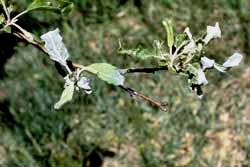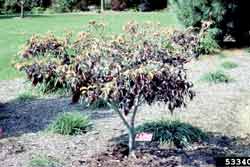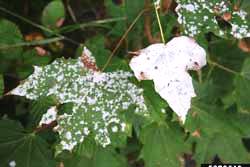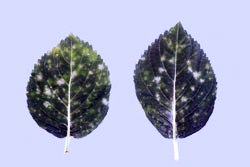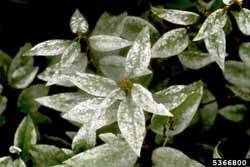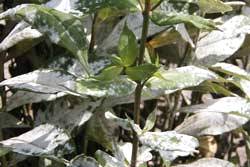Powdery Mildew
Powdery mildews are caused by a variety of fungi, each specific to a host plant. It is recognizable by the patches of white fungal growth on the upper leaf surface. Commonly infected woody ornamentals include lilac, flowering dogwood, azalea, rose, and hydrangea. Flowering plants commonly infected include phlox, bee-balm, aster, yarrow, coreopsis, rudbeckia, begonia, chrysanthemum, dahlia, delphinium, snapdragon and zinnia. Since different fungi infect specific plants, it is not possible to spread from one species to another, for example, powdery mildew on phlox will not affect lilac.
Click on images to view full-size
Identification and Control Information
- Integrated Pest Management for Home Gardeners and Landscape Professionals: Powdery Mildew on Ornamentals[PDF]—University of California
- Fact Sheet with Symptoms and Control Options (PDF)—Colorado State University Extension
- Powdery Mildew on Shrubs, Fact Sheet with Symptoms and Control Options—University of Rhode Island Landscape Horticulture Program
- Tips for Managing Powdery Mildew (PDF)—Maine Integrated Pest Management Council
More Information
- Integrated Pest Management of Roses—Cornell University Department of Horticulture
[Photos, left to right: William M. Brown Jr., Bugwood.org; Mary Ann Hansen, Virginia Polytechnic Institute and State University, Bugwood.org; Andrej Kunca, National Forest Centre - Slovakia, Bugwood.org; Department of Plant Pathology Archive, North Carolina State University, Bugwood.org; Whitney Cranshaw, Colorado State University, Bugwood.org; The Dow Gardens Archive, Dow Gardens, Bugwood.org]
